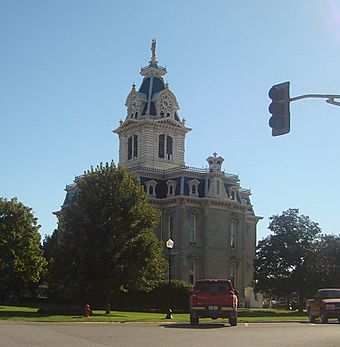Davis County Courthouse (Iowa) facts for kids
Quick facts for kids |
|
|
Davis County Courthouse
|
|
|
U.S. Historic district
Contributing property |
|
 |
|
| Location | Bloomfield Town Square Bloomfield, Iowa |
|---|---|
| Area | 3 acres (1.2 ha) |
| Built | 1877 |
| Built by | John Lane Larkworthy and Menke |
| Architect | T.J. Tolan & Sons |
| Architectural style | Second Empire |
| Part of | Bloomfield Square (ID76000756) |
| MPS | County Courthouses in Iowa TR |
| NRHP reference No. | 74000779 |
| Added to NRHP | May 3, 1974 |
The Davis County Courthouse is an important building in Bloomfield, Iowa. It was built a long time ago, in 1877. This courthouse is special because it's where important county decisions are made and where court cases happen. It was added to a list of special places called the National Register of Historic Places in 1974. It's also part of a historic area called Bloomfield Square.
Contents
A Look Back: The Courthouse Story
Early Days and Challenges
Before the current courthouse, Davis County had a much smaller building. Their first courthouse was made of logs and had two stories. It was built for only $339.
After some years, this log building became too old to use. By 1851, the county had to rent space for court meetings. They even used a Methodist church for a courtroom starting in 1863.
The county was paying a lot of money in rent each year. People kept voting against building a new courthouse. Finally, in 1875, voters agreed to build the courthouse we see today. They decided it should not cost more than $50,000.
Building the New Courthouse
The new courthouse was designed by T.J. Tolan & Sons, an architecture firm from Fort Wayne, Indiana. John Lane was in charge of building it. Larkworthy and Menke, from Quincy, Illinois, did the stonework.
The bell in the tower was made in 1876 by the Kimberly Bell Works. The four-faced clock was also made in 1876 by the Seth Thomas Clock Company. The whole building was finished in 1877. The old log courthouse was sold for $50 and moved to a farm to be used as a house.
A Place for Everyone
Besides being a place for court and county business, the courthouse has always been a center for community events. Over the years, it has hosted many different gatherings. These include band concerts, barbecues, and important community rallies. During World War II, it was even a place for scrap metal drives to help the war effort.
What the Courthouse Looks Like
Design and Materials
The Davis County Courthouse is built in a style called "Second Empire." This style was popular after the American Civil War. It's sometimes called "General Grant Gothic." The building is surrounded by a large, landscaped park.
The courthouse has two stories and is about 97 feet (29.6 meters) long and 87 feet (26.5 meters) wide. Its thick brick walls are covered with special stone called Bedford stone.
Special Features
The building has a unique roof called a mansard roof. It also has a tall cupola in the center. This cupola acts as both a bell tower and a clock tower. You can also see decorative roof cresting and fancy brackets under the roof edges. The windows are trimmed with the same Bedford stone.
The central tower is made of wood. On top of it stands a statue of the goddess of Justice. She represents fairness and law. This statue and the tower are so tall that you can see them from far away. They are a main landmark for the whole community.



